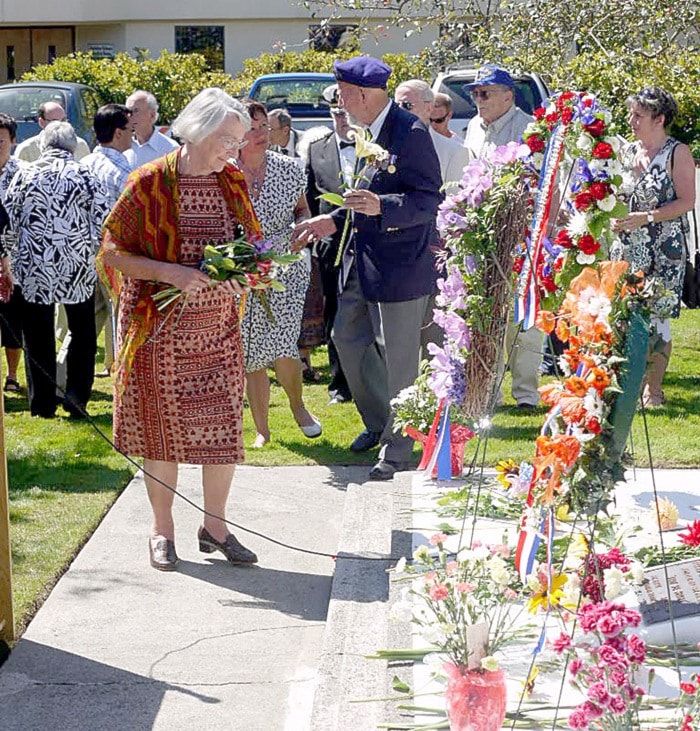When a Second World War-era Harvard and Tiger Moth from the Canadian Museum of Flight fly over the White Rock Cenotaph on Saturday. it will not only mark the end of the ceremony but also – most likely – the end of an era.
"We're all getting too old to go on organizing this," said Dirk Doornberg, 80, a member of the August 15 Foundation which, for decades, has commemorated the date of Japan's formal surrender to Allied Forces at the end of the Second World War – and those civilians who suffered or perished in Japanese internment camps in Indonesia.
"We've said often that this might be the last time, but if we get enough people, we'll be looking at ways this can go on," said foundation president Willem Stronch, 73, who explained the Canadian commemoration has traditionally been held at the White Rock Cenotaph.
"It's the only plaque in the whole of Canada that remembers people who died in the Pacific War," Stronch said. "It's understandable – most Canadians were involved with the war in Europe."
The 11 a.m. ceremony will feature a flag lowering to half mast, a minute of silence to remember the victims, the bagpipes of Tony Warburton and presentations by the City of White Rock and Thekla Lit, president of B.C. Alpha, an association dedicated to learning from and preserving the history of the Second World War in Asia.
Prominent in the ceremony will be Gert Heijkoop, Netherlands Consul General, who will be among those laying wreaths at the cenotaph.
Most of the 150 people expected to gather at the cenotaph are of Dutch origins – either those who were held in the concentration camps in Indonesia during the war, or their relatives.
The civilians were imprisoned in the region's numerous camps from early-1942 – when Japanese forces conquered the former Dutch East Indies – until the end of the war.
It's a grim irony, Stronch and Doornberg say, that they, like other survivors of the camps, owe their own lives to an appalling loss of life – the U.S. dropping of atomic bombs on the Japanese cities of Hiroshima and Nagasaki in 1945 on Aug. 6 and 9.
The awful destructive power those weapons unleashed on Japan persuaded Emperor Hirohito to overrule militarists in the government and order a surrender rather than prolong an island-by-island struggle between Japanese and U.S. troops in the Pacific – one that U.S. logistical experts were predicting would drag on into the 1950s.
"Otherwise, the Japanese would never have surrendered – it was part of their religion, their oath to their emperor. They would have gone on fighting in the rocks and holes in the mountains," Stronch said. "But (President) Truman said, after Nagasaki, that if they didn't surrender, Tokyo will be bombed.
"I guess it's always the civilians that suffer in wartime. So the bombs were not a good solution – but a lot of lives were saved, especially young American lives."
For 3½ years before the surrender, the Dutch community – many of them second- and third-generation colonists overseeing rubber and tobacco plantations in the region – had suffered numerous hardships at the hands of the Japanese occupiers.
Brutal treatment was definitely a factor, but most consistent problems, Stronch and Doornberg say, were a lack of medication and a shortage of food that left many sick or dead from malnourishment.
Families were split up – fathers and uncles and boys over 11 were taken to forced-labour camps, while women and younger children had to live without most basic necessities.
It was only when the war ended that they discovered the fate of loved ones. Stronch said it was then, through the Red Cross, that his mother learned that his father had perished eight months earlier.
"She always told me she didn't want to speak too much about the war, but she did say, if it wasn't for my brother and me, she would not have survived," he said, noting he only has vague memories of the incarceration.
"I was born the week before Pearl Harbour and my brother was six turning seven, so we were in the camp in Palembang with my mother all through the war," he said. "We were too young to go with the other boys."
Doornberg, who was 10 when the war ended, found out that his father had survived one camp but his two older brothers had gone to another camp – where one perished at the age of 17.
He said it's calculated that one-in-six of the interned civilians died during their imprisonment – an estimated 30,000 deaths and statistically an even higher mortality rate than that among combatants.
Even after the surrender, the ordeal was far from over for the residents of the Dutch colony, Stronch and Doornberg said.
Although no longer held by the Japanese, formal liberation by Allied forces was months away, and they still depended on parachute drops of food and other supplies.
And the Japanese had long promised liberation for the colonies' indigenous people, and had raised and armed militias among the native population.
Some of these Indonesian nationalists, loyal to newly proclaimed Indonesian president Sukarno, launched attacks on the Dutch who were attempting to return to their homes and possessions, until the Allies pointed out to the Japanese forces that, under the terms of surrender, they were still responsible for the internees,
In another grim irony of the war, the former Japanese captors, better equipped and trained than the native militias, took up arms again – to protect the Europeans until the Allies arrived.
"It was a time of great turbulence," Doornberg remembered, adding that it was October 1945 before British forces – including Gurka troops – arrived to officially liberate some 8,000 residents of his camp in Samerang.
"Boy, were they ever a sight for sore eyes," he said.
